Analysis of Cross-Cultural Management and Global Leadership Essay
VerifiedAdded on 2021/05/31
|8
|2641
|138
Essay
AI Summary
This essay provides an in-depth analysis of the evolution of global leadership from the perspective of cross-cultural management. It examines the historical context, key concepts, and the influence of various streams of research, including expatriation, intercultural communication, comparative leadership, and global management. The essay explores the competencies, attributes, and skills essential for global leaders, drawing on empirical studies and research findings. It discusses evidence supporting and challenging the author's arguments, highlighting the multifaceted nature of global leadership and the importance of emotional and cultural intelligence. The essay concludes by acknowledging the limitations of the research while emphasizing the need for adaptability and innovation in the face of global changes, making it a valuable resource for students studying leadership and management.
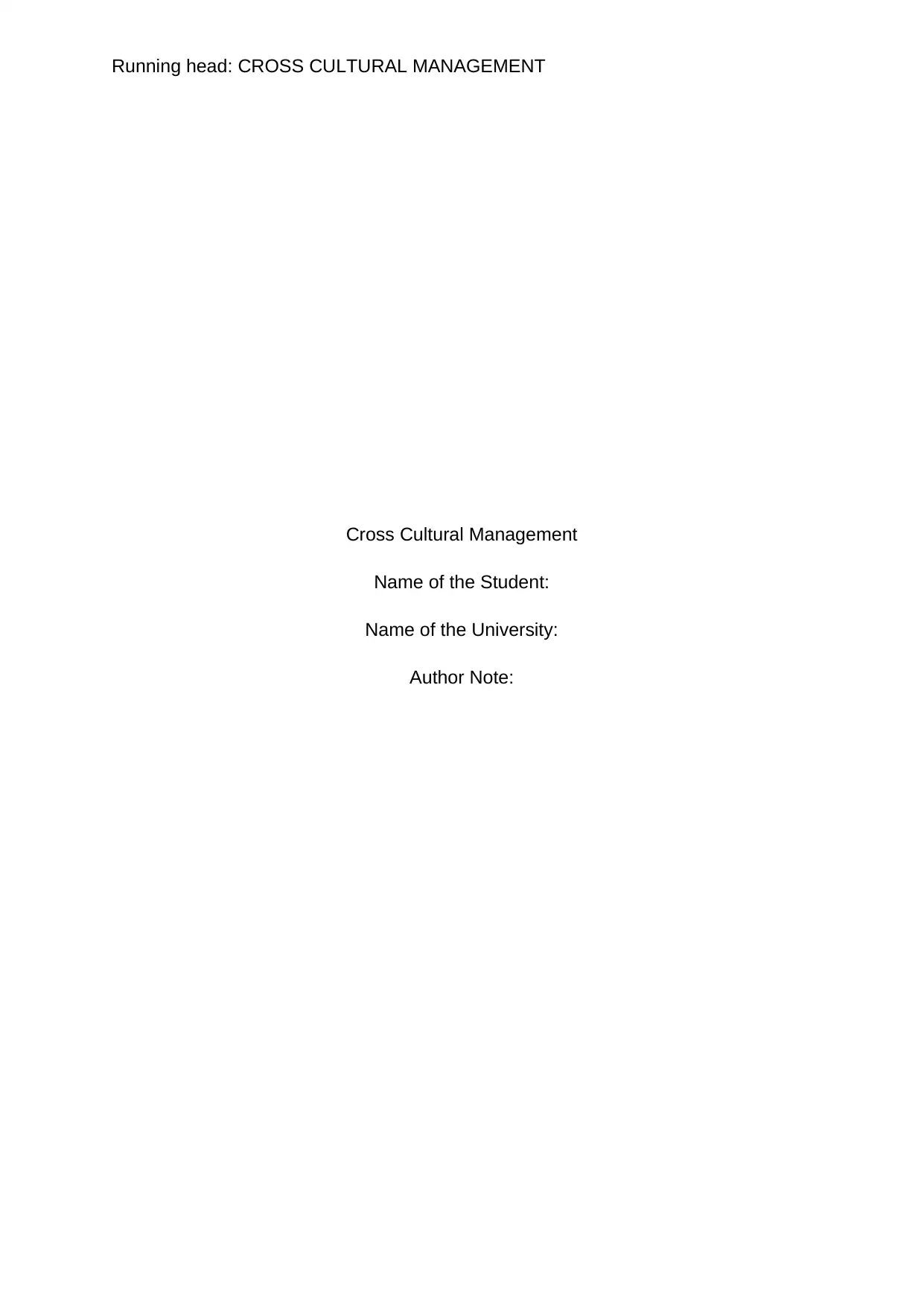
Running head: CROSS CULTURAL MANAGEMENT
Cross Cultural Management
Name of the Student:
Name of the University:
Author Note:
Cross Cultural Management
Name of the Student:
Name of the University:
Author Note:
Paraphrase This Document
Need a fresh take? Get an instant paraphrase of this document with our AI Paraphraser
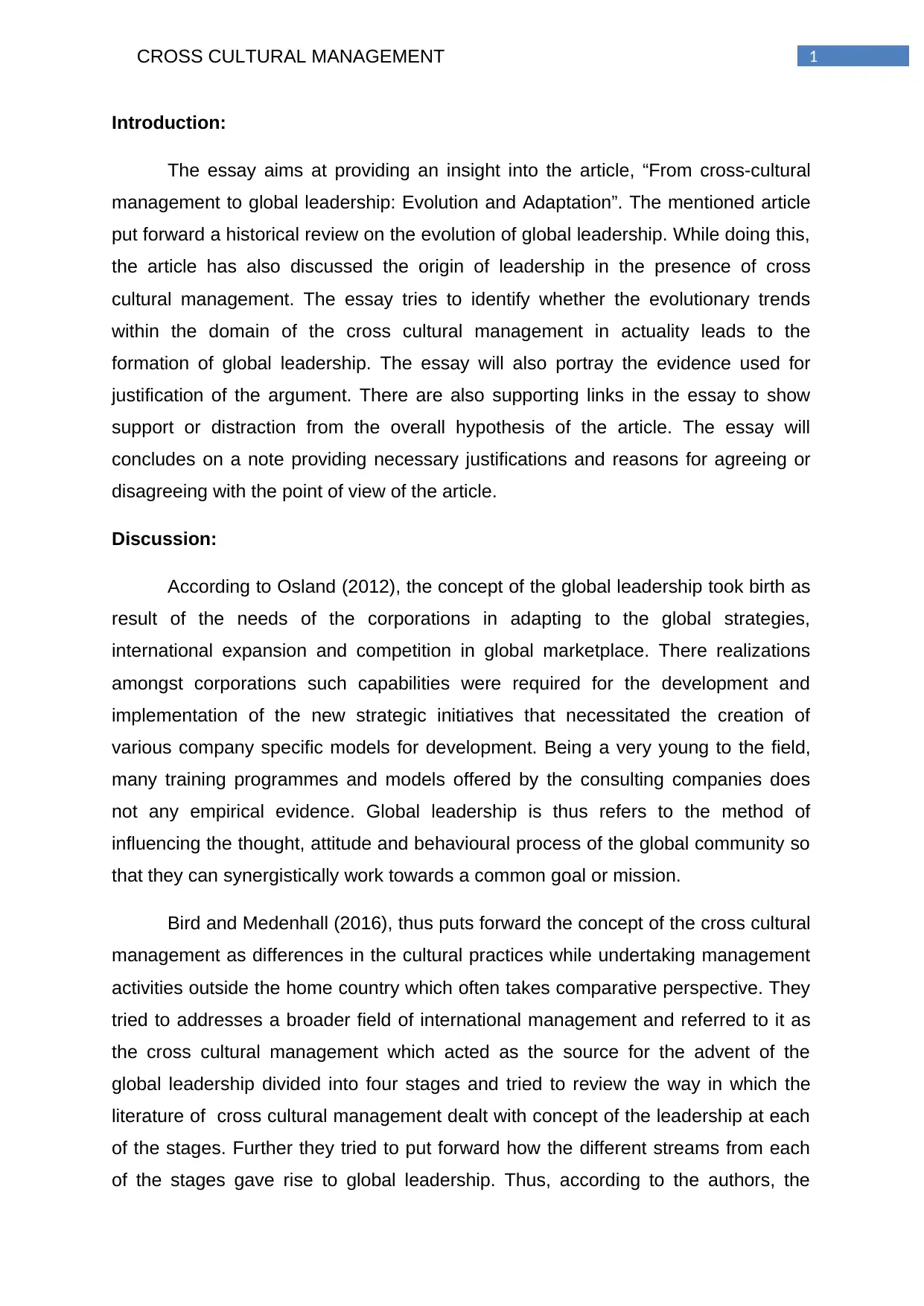
1CROSS CULTURAL MANAGEMENT
Introduction:
The essay aims at providing an insight into the article, “From cross-cultural
management to global leadership: Evolution and Adaptation”. The mentioned article
put forward a historical review on the evolution of global leadership. While doing this,
the article has also discussed the origin of leadership in the presence of cross
cultural management. The essay tries to identify whether the evolutionary trends
within the domain of the cross cultural management in actuality leads to the
formation of global leadership. The essay will also portray the evidence used for
justification of the argument. There are also supporting links in the essay to show
support or distraction from the overall hypothesis of the article. The essay will
concludes on a note providing necessary justifications and reasons for agreeing or
disagreeing with the point of view of the article.
Discussion:
According to Osland (2012), the concept of the global leadership took birth as
result of the needs of the corporations in adapting to the global strategies,
international expansion and competition in global marketplace. There realizations
amongst corporations such capabilities were required for the development and
implementation of the new strategic initiatives that necessitated the creation of
various company specific models for development. Being a very young to the field,
many training programmes and models offered by the consulting companies does
not any empirical evidence. Global leadership is thus refers to the method of
influencing the thought, attitude and behavioural process of the global community so
that they can synergistically work towards a common goal or mission.
Bird and Medenhall (2016), thus puts forward the concept of the cross cultural
management as differences in the cultural practices while undertaking management
activities outside the home country which often takes comparative perspective. They
tried to addresses a broader field of international management and referred to it as
the cross cultural management which acted as the source for the advent of the
global leadership divided into four stages and tried to review the way in which the
literature of cross cultural management dealt with concept of the leadership at each
of the stages. Further they tried to put forward how the different streams from each
of the stages gave rise to global leadership. Thus, according to the authors, the
Introduction:
The essay aims at providing an insight into the article, “From cross-cultural
management to global leadership: Evolution and Adaptation”. The mentioned article
put forward a historical review on the evolution of global leadership. While doing this,
the article has also discussed the origin of leadership in the presence of cross
cultural management. The essay tries to identify whether the evolutionary trends
within the domain of the cross cultural management in actuality leads to the
formation of global leadership. The essay will also portray the evidence used for
justification of the argument. There are also supporting links in the essay to show
support or distraction from the overall hypothesis of the article. The essay will
concludes on a note providing necessary justifications and reasons for agreeing or
disagreeing with the point of view of the article.
Discussion:
According to Osland (2012), the concept of the global leadership took birth as
result of the needs of the corporations in adapting to the global strategies,
international expansion and competition in global marketplace. There realizations
amongst corporations such capabilities were required for the development and
implementation of the new strategic initiatives that necessitated the creation of
various company specific models for development. Being a very young to the field,
many training programmes and models offered by the consulting companies does
not any empirical evidence. Global leadership is thus refers to the method of
influencing the thought, attitude and behavioural process of the global community so
that they can synergistically work towards a common goal or mission.
Bird and Medenhall (2016), thus puts forward the concept of the cross cultural
management as differences in the cultural practices while undertaking management
activities outside the home country which often takes comparative perspective. They
tried to addresses a broader field of international management and referred to it as
the cross cultural management which acted as the source for the advent of the
global leadership divided into four stages and tried to review the way in which the
literature of cross cultural management dealt with concept of the leadership at each
of the stages. Further they tried to put forward how the different streams from each
of the stages gave rise to global leadership. Thus, according to the authors, the
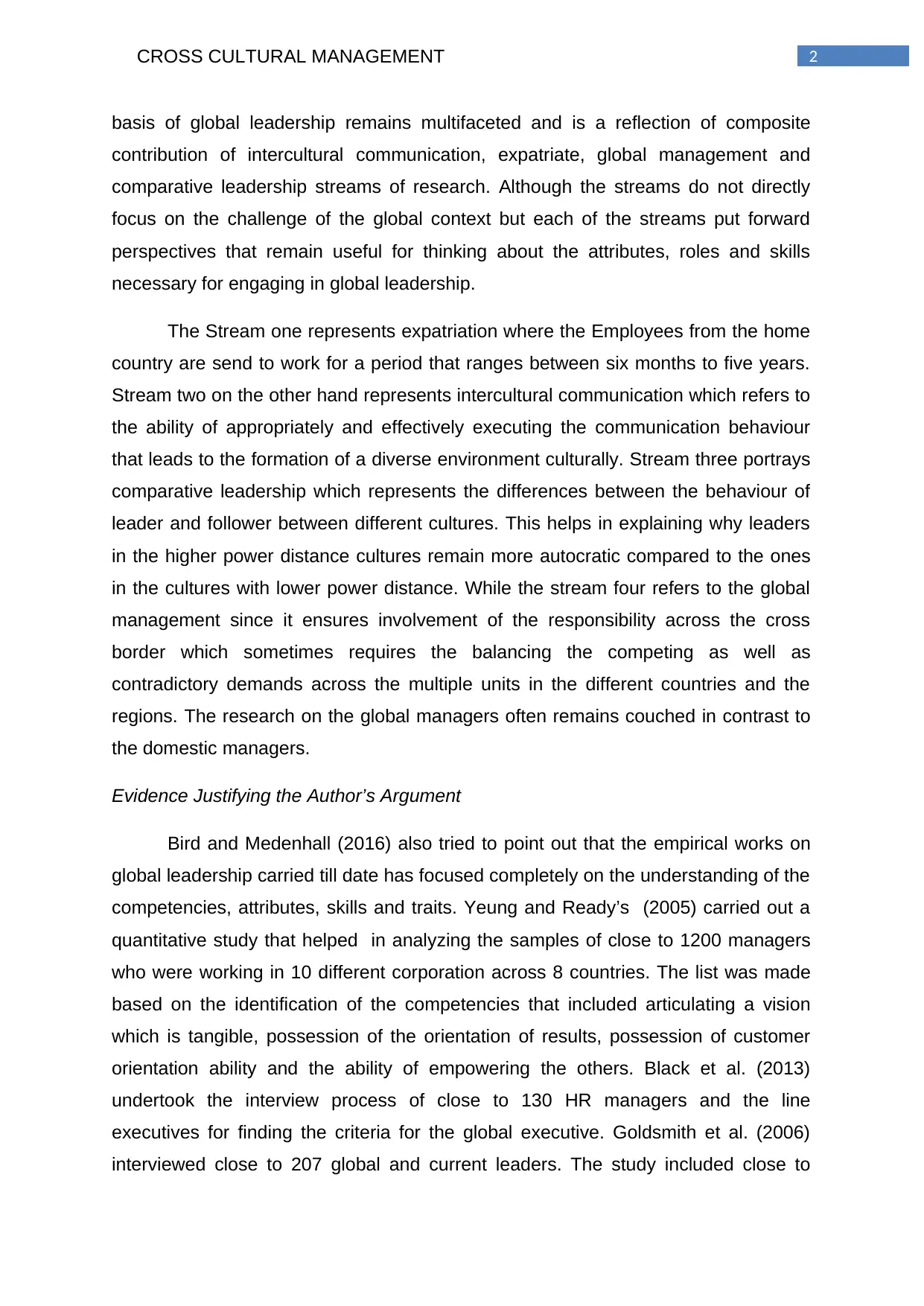
2CROSS CULTURAL MANAGEMENT
basis of global leadership remains multifaceted and is a reflection of composite
contribution of intercultural communication, expatriate, global management and
comparative leadership streams of research. Although the streams do not directly
focus on the challenge of the global context but each of the streams put forward
perspectives that remain useful for thinking about the attributes, roles and skills
necessary for engaging in global leadership.
The Stream one represents expatriation where the Employees from the home
country are send to work for a period that ranges between six months to five years.
Stream two on the other hand represents intercultural communication which refers to
the ability of appropriately and effectively executing the communication behaviour
that leads to the formation of a diverse environment culturally. Stream three portrays
comparative leadership which represents the differences between the behaviour of
leader and follower between different cultures. This helps in explaining why leaders
in the higher power distance cultures remain more autocratic compared to the ones
in the cultures with lower power distance. While the stream four refers to the global
management since it ensures involvement of the responsibility across the cross
border which sometimes requires the balancing the competing as well as
contradictory demands across the multiple units in the different countries and the
regions. The research on the global managers often remains couched in contrast to
the domestic managers.
Evidence Justifying the Author’s Argument
Bird and Medenhall (2016) also tried to point out that the empirical works on
global leadership carried till date has focused completely on the understanding of the
competencies, attributes, skills and traits. Yeung and Ready’s (2005) carried out a
quantitative study that helped in analyzing the samples of close to 1200 managers
who were working in 10 different corporation across 8 countries. The list was made
based on the identification of the competencies that included articulating a vision
which is tangible, possession of the orientation of results, possession of customer
orientation ability and the ability of empowering the others. Black et al. (2013)
undertook the interview process of close to 130 HR managers and the line
executives for finding the criteria for the global executive. Goldsmith et al. (2006)
interviewed close to 207 global and current leaders. The study included close to
basis of global leadership remains multifaceted and is a reflection of composite
contribution of intercultural communication, expatriate, global management and
comparative leadership streams of research. Although the streams do not directly
focus on the challenge of the global context but each of the streams put forward
perspectives that remain useful for thinking about the attributes, roles and skills
necessary for engaging in global leadership.
The Stream one represents expatriation where the Employees from the home
country are send to work for a period that ranges between six months to five years.
Stream two on the other hand represents intercultural communication which refers to
the ability of appropriately and effectively executing the communication behaviour
that leads to the formation of a diverse environment culturally. Stream three portrays
comparative leadership which represents the differences between the behaviour of
leader and follower between different cultures. This helps in explaining why leaders
in the higher power distance cultures remain more autocratic compared to the ones
in the cultures with lower power distance. While the stream four refers to the global
management since it ensures involvement of the responsibility across the cross
border which sometimes requires the balancing the competing as well as
contradictory demands across the multiple units in the different countries and the
regions. The research on the global managers often remains couched in contrast to
the domestic managers.
Evidence Justifying the Author’s Argument
Bird and Medenhall (2016) also tried to point out that the empirical works on
global leadership carried till date has focused completely on the understanding of the
competencies, attributes, skills and traits. Yeung and Ready’s (2005) carried out a
quantitative study that helped in analyzing the samples of close to 1200 managers
who were working in 10 different corporation across 8 countries. The list was made
based on the identification of the competencies that included articulating a vision
which is tangible, possession of the orientation of results, possession of customer
orientation ability and the ability of empowering the others. Black et al. (2013)
undertook the interview process of close to 130 HR managers and the line
executives for finding the criteria for the global executive. Goldsmith et al. (2006)
interviewed close to 207 global and current leaders. The study included close to
⊘ This is a preview!⊘
Do you want full access?
Subscribe today to unlock all pages.

Trusted by 1+ million students worldwide
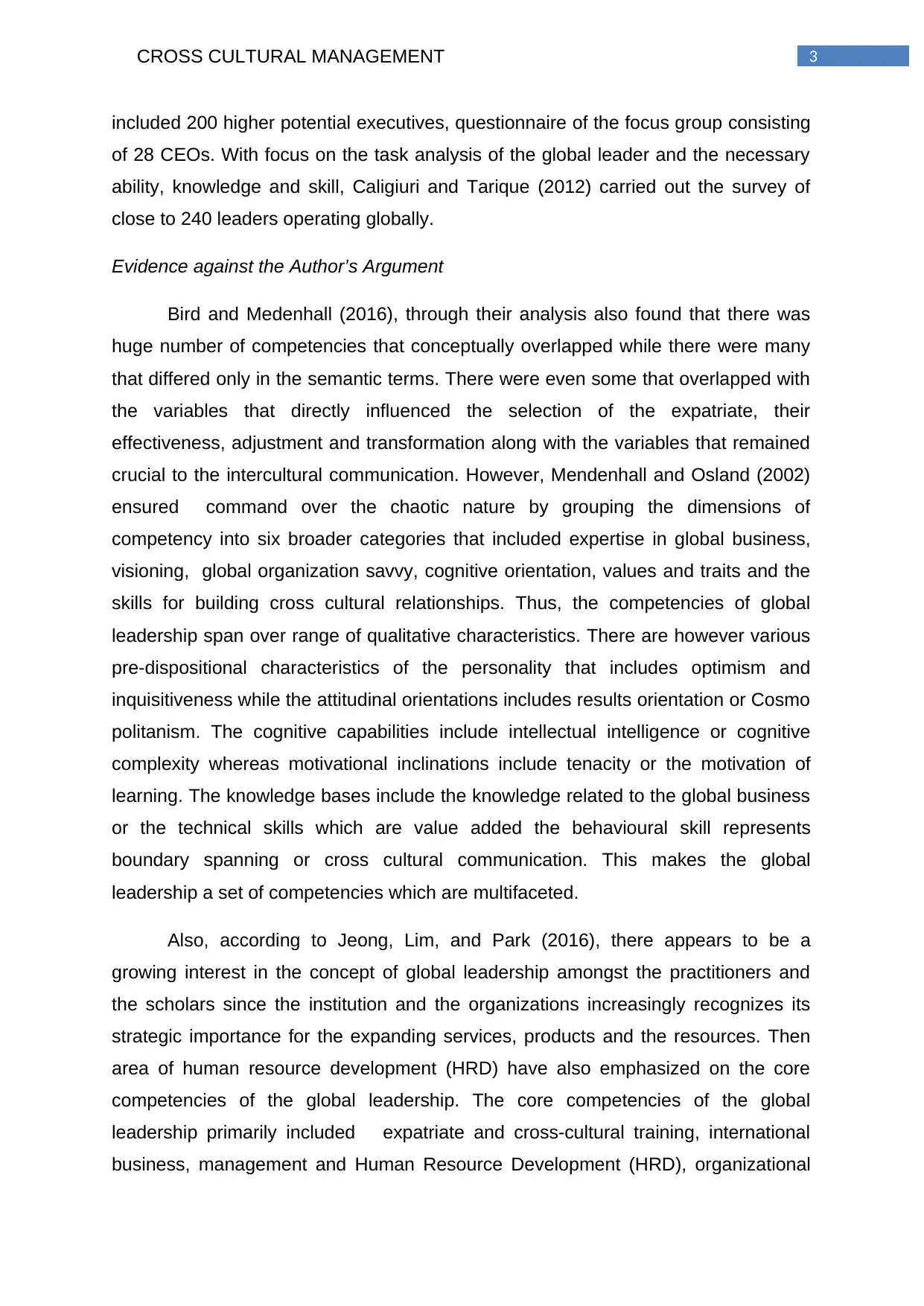
3CROSS CULTURAL MANAGEMENT
included 200 higher potential executives, questionnaire of the focus group consisting
of 28 CEOs. With focus on the task analysis of the global leader and the necessary
ability, knowledge and skill, Caligiuri and Tarique (2012) carried out the survey of
close to 240 leaders operating globally.
Evidence against the Author’s Argument
Bird and Medenhall (2016), through their analysis also found that there was
huge number of competencies that conceptually overlapped while there were many
that differed only in the semantic terms. There were even some that overlapped with
the variables that directly influenced the selection of the expatriate, their
effectiveness, adjustment and transformation along with the variables that remained
crucial to the intercultural communication. However, Mendenhall and Osland (2002)
ensured command over the chaotic nature by grouping the dimensions of
competency into six broader categories that included expertise in global business,
visioning, global organization savvy, cognitive orientation, values and traits and the
skills for building cross cultural relationships. Thus, the competencies of global
leadership span over range of qualitative characteristics. There are however various
pre-dispositional characteristics of the personality that includes optimism and
inquisitiveness while the attitudinal orientations includes results orientation or Cosmo
politanism. The cognitive capabilities include intellectual intelligence or cognitive
complexity whereas motivational inclinations include tenacity or the motivation of
learning. The knowledge bases include the knowledge related to the global business
or the technical skills which are value added the behavioural skill represents
boundary spanning or cross cultural communication. This makes the global
leadership a set of competencies which are multifaceted.
Also, according to Jeong, Lim, and Park (2016), there appears to be a
growing interest in the concept of global leadership amongst the practitioners and
the scholars since the institution and the organizations increasingly recognizes its
strategic importance for the expanding services, products and the resources. Then
area of human resource development (HRD) have also emphasized on the core
competencies of the global leadership. The core competencies of the global
leadership primarily included expatriate and cross-cultural training, international
business, management and Human Resource Development (HRD), organizational
included 200 higher potential executives, questionnaire of the focus group consisting
of 28 CEOs. With focus on the task analysis of the global leader and the necessary
ability, knowledge and skill, Caligiuri and Tarique (2012) carried out the survey of
close to 240 leaders operating globally.
Evidence against the Author’s Argument
Bird and Medenhall (2016), through their analysis also found that there was
huge number of competencies that conceptually overlapped while there were many
that differed only in the semantic terms. There were even some that overlapped with
the variables that directly influenced the selection of the expatriate, their
effectiveness, adjustment and transformation along with the variables that remained
crucial to the intercultural communication. However, Mendenhall and Osland (2002)
ensured command over the chaotic nature by grouping the dimensions of
competency into six broader categories that included expertise in global business,
visioning, global organization savvy, cognitive orientation, values and traits and the
skills for building cross cultural relationships. Thus, the competencies of global
leadership span over range of qualitative characteristics. There are however various
pre-dispositional characteristics of the personality that includes optimism and
inquisitiveness while the attitudinal orientations includes results orientation or Cosmo
politanism. The cognitive capabilities include intellectual intelligence or cognitive
complexity whereas motivational inclinations include tenacity or the motivation of
learning. The knowledge bases include the knowledge related to the global business
or the technical skills which are value added the behavioural skill represents
boundary spanning or cross cultural communication. This makes the global
leadership a set of competencies which are multifaceted.
Also, according to Jeong, Lim, and Park (2016), there appears to be a
growing interest in the concept of global leadership amongst the practitioners and
the scholars since the institution and the organizations increasingly recognizes its
strategic importance for the expanding services, products and the resources. Then
area of human resource development (HRD) have also emphasized on the core
competencies of the global leadership. The core competencies of the global
leadership primarily included expatriate and cross-cultural training, international
business, management and Human Resource Development (HRD), organizational
Paraphrase This Document
Need a fresh take? Get an instant paraphrase of this document with our AI Paraphraser
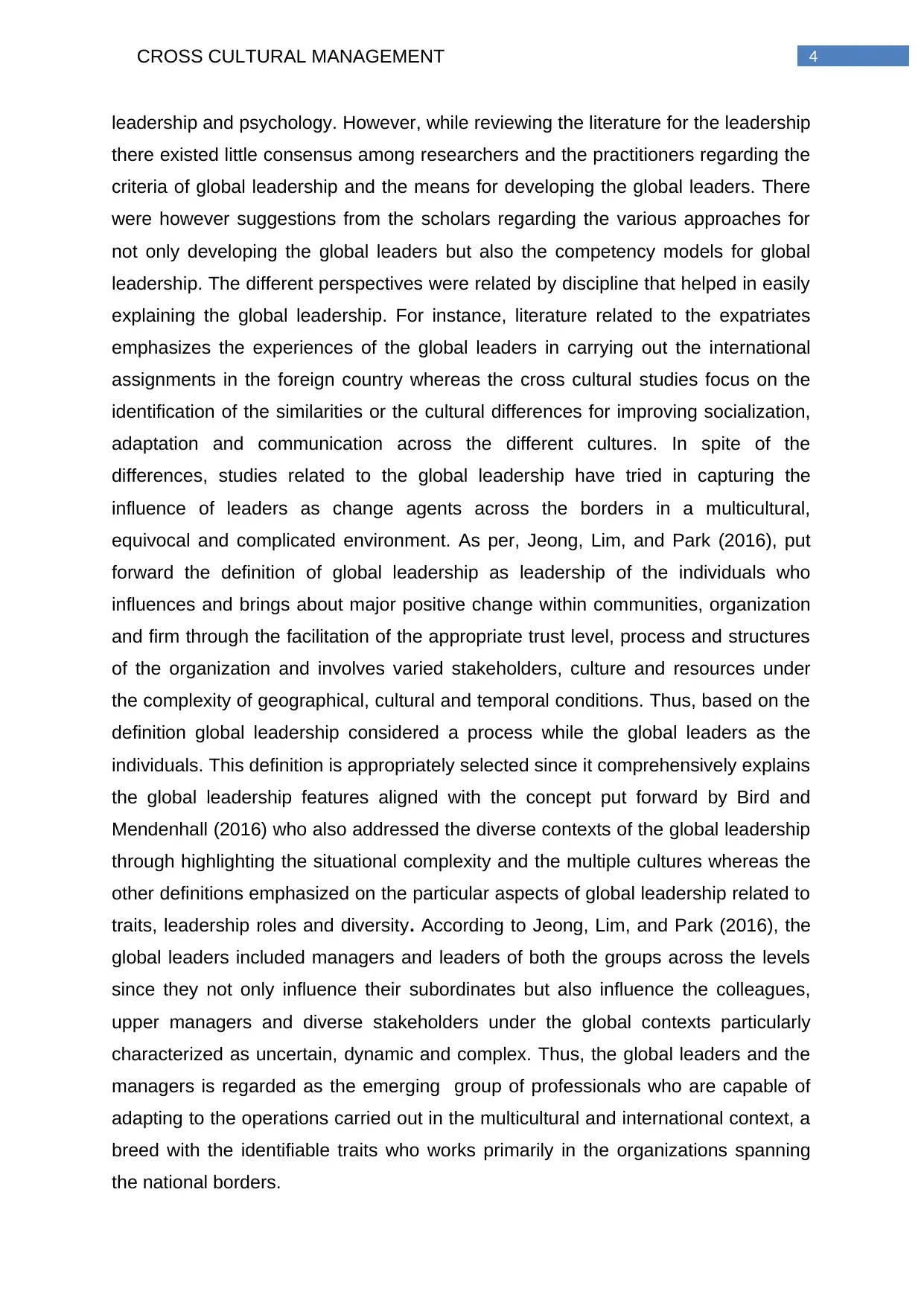
4CROSS CULTURAL MANAGEMENT
leadership and psychology. However, while reviewing the literature for the leadership
there existed little consensus among researchers and the practitioners regarding the
criteria of global leadership and the means for developing the global leaders. There
were however suggestions from the scholars regarding the various approaches for
not only developing the global leaders but also the competency models for global
leadership. The different perspectives were related by discipline that helped in easily
explaining the global leadership. For instance, literature related to the expatriates
emphasizes the experiences of the global leaders in carrying out the international
assignments in the foreign country whereas the cross cultural studies focus on the
identification of the similarities or the cultural differences for improving socialization,
adaptation and communication across the different cultures. In spite of the
differences, studies related to the global leadership have tried in capturing the
influence of leaders as change agents across the borders in a multicultural,
equivocal and complicated environment. As per, Jeong, Lim, and Park (2016), put
forward the definition of global leadership as leadership of the individuals who
influences and brings about major positive change within communities, organization
and firm through the facilitation of the appropriate trust level, process and structures
of the organization and involves varied stakeholders, culture and resources under
the complexity of geographical, cultural and temporal conditions. Thus, based on the
definition global leadership considered a process while the global leaders as the
individuals. This definition is appropriately selected since it comprehensively explains
the global leadership features aligned with the concept put forward by Bird and
Mendenhall (2016) who also addressed the diverse contexts of the global leadership
through highlighting the situational complexity and the multiple cultures whereas the
other definitions emphasized on the particular aspects of global leadership related to
traits, leadership roles and diversity. According to Jeong, Lim, and Park (2016), the
global leaders included managers and leaders of both the groups across the levels
since they not only influence their subordinates but also influence the colleagues,
upper managers and diverse stakeholders under the global contexts particularly
characterized as uncertain, dynamic and complex. Thus, the global leaders and the
managers is regarded as the emerging group of professionals who are capable of
adapting to the operations carried out in the multicultural and international context, a
breed with the identifiable traits who works primarily in the organizations spanning
the national borders.
leadership and psychology. However, while reviewing the literature for the leadership
there existed little consensus among researchers and the practitioners regarding the
criteria of global leadership and the means for developing the global leaders. There
were however suggestions from the scholars regarding the various approaches for
not only developing the global leaders but also the competency models for global
leadership. The different perspectives were related by discipline that helped in easily
explaining the global leadership. For instance, literature related to the expatriates
emphasizes the experiences of the global leaders in carrying out the international
assignments in the foreign country whereas the cross cultural studies focus on the
identification of the similarities or the cultural differences for improving socialization,
adaptation and communication across the different cultures. In spite of the
differences, studies related to the global leadership have tried in capturing the
influence of leaders as change agents across the borders in a multicultural,
equivocal and complicated environment. As per, Jeong, Lim, and Park (2016), put
forward the definition of global leadership as leadership of the individuals who
influences and brings about major positive change within communities, organization
and firm through the facilitation of the appropriate trust level, process and structures
of the organization and involves varied stakeholders, culture and resources under
the complexity of geographical, cultural and temporal conditions. Thus, based on the
definition global leadership considered a process while the global leaders as the
individuals. This definition is appropriately selected since it comprehensively explains
the global leadership features aligned with the concept put forward by Bird and
Mendenhall (2016) who also addressed the diverse contexts of the global leadership
through highlighting the situational complexity and the multiple cultures whereas the
other definitions emphasized on the particular aspects of global leadership related to
traits, leadership roles and diversity. According to Jeong, Lim, and Park (2016), the
global leaders included managers and leaders of both the groups across the levels
since they not only influence their subordinates but also influence the colleagues,
upper managers and diverse stakeholders under the global contexts particularly
characterized as uncertain, dynamic and complex. Thus, the global leaders and the
managers is regarded as the emerging group of professionals who are capable of
adapting to the operations carried out in the multicultural and international context, a
breed with the identifiable traits who works primarily in the organizations spanning
the national borders.
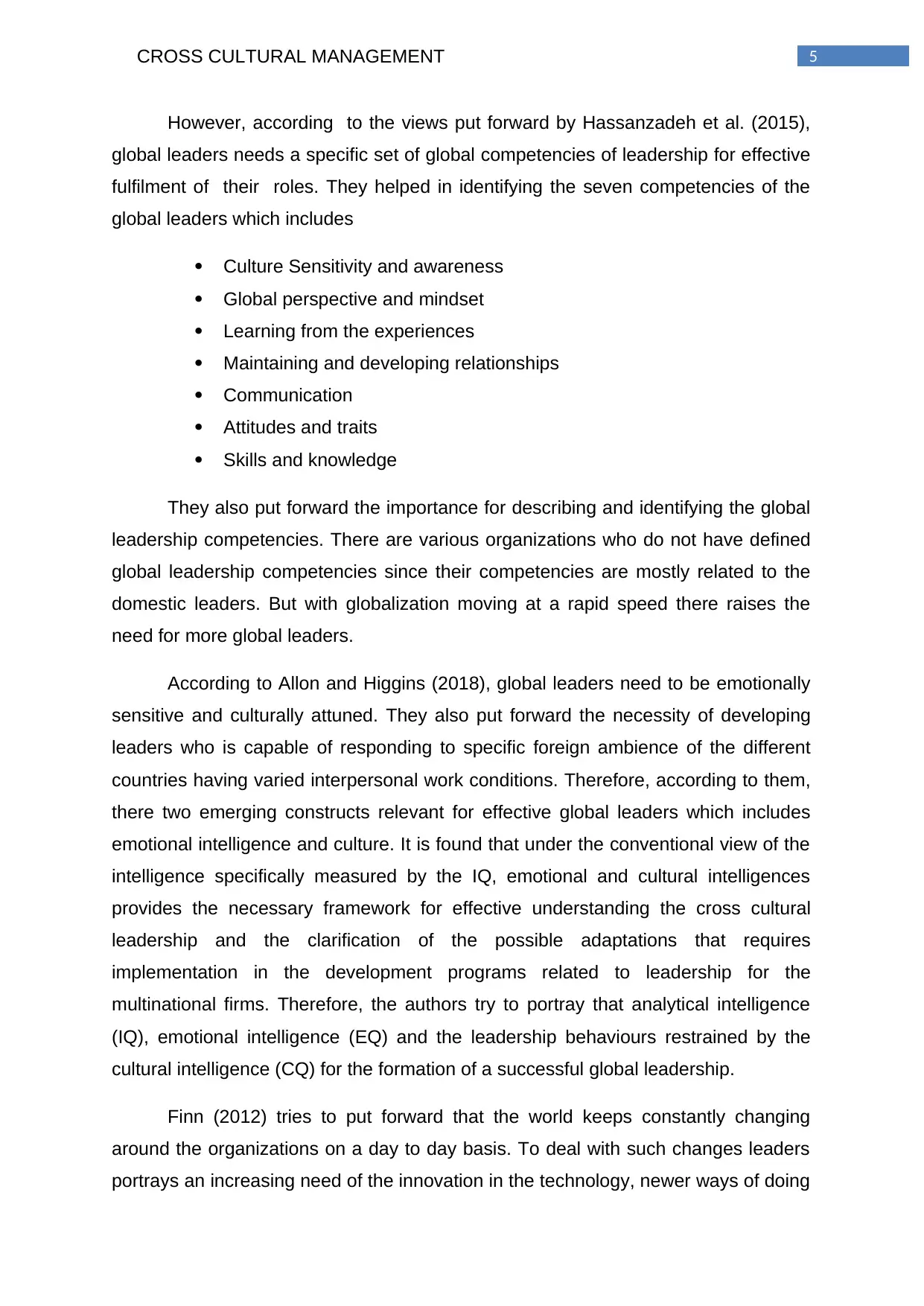
5CROSS CULTURAL MANAGEMENT
However, according to the views put forward by Hassanzadeh et al. (2015),
global leaders needs a specific set of global competencies of leadership for effective
fulfilment of their roles. They helped in identifying the seven competencies of the
global leaders which includes
Culture Sensitivity and awareness
Global perspective and mindset
Learning from the experiences
Maintaining and developing relationships
Communication
Attitudes and traits
Skills and knowledge
They also put forward the importance for describing and identifying the global
leadership competencies. There are various organizations who do not have defined
global leadership competencies since their competencies are mostly related to the
domestic leaders. But with globalization moving at a rapid speed there raises the
need for more global leaders.
According to Allon and Higgins (2018), global leaders need to be emotionally
sensitive and culturally attuned. They also put forward the necessity of developing
leaders who is capable of responding to specific foreign ambience of the different
countries having varied interpersonal work conditions. Therefore, according to them,
there two emerging constructs relevant for effective global leaders which includes
emotional intelligence and culture. It is found that under the conventional view of the
intelligence specifically measured by the IQ, emotional and cultural intelligences
provides the necessary framework for effective understanding the cross cultural
leadership and the clarification of the possible adaptations that requires
implementation in the development programs related to leadership for the
multinational firms. Therefore, the authors try to portray that analytical intelligence
(IQ), emotional intelligence (EQ) and the leadership behaviours restrained by the
cultural intelligence (CQ) for the formation of a successful global leadership.
Finn (2012) tries to put forward that the world keeps constantly changing
around the organizations on a day to day basis. To deal with such changes leaders
portrays an increasing need of the innovation in the technology, newer ways of doing
However, according to the views put forward by Hassanzadeh et al. (2015),
global leaders needs a specific set of global competencies of leadership for effective
fulfilment of their roles. They helped in identifying the seven competencies of the
global leaders which includes
Culture Sensitivity and awareness
Global perspective and mindset
Learning from the experiences
Maintaining and developing relationships
Communication
Attitudes and traits
Skills and knowledge
They also put forward the importance for describing and identifying the global
leadership competencies. There are various organizations who do not have defined
global leadership competencies since their competencies are mostly related to the
domestic leaders. But with globalization moving at a rapid speed there raises the
need for more global leaders.
According to Allon and Higgins (2018), global leaders need to be emotionally
sensitive and culturally attuned. They also put forward the necessity of developing
leaders who is capable of responding to specific foreign ambience of the different
countries having varied interpersonal work conditions. Therefore, according to them,
there two emerging constructs relevant for effective global leaders which includes
emotional intelligence and culture. It is found that under the conventional view of the
intelligence specifically measured by the IQ, emotional and cultural intelligences
provides the necessary framework for effective understanding the cross cultural
leadership and the clarification of the possible adaptations that requires
implementation in the development programs related to leadership for the
multinational firms. Therefore, the authors try to portray that analytical intelligence
(IQ), emotional intelligence (EQ) and the leadership behaviours restrained by the
cultural intelligence (CQ) for the formation of a successful global leadership.
Finn (2012) tries to put forward that the world keeps constantly changing
around the organizations on a day to day basis. To deal with such changes leaders
portrays an increasing need of the innovation in the technology, newer ways of doing
⊘ This is a preview!⊘
Do you want full access?
Subscribe today to unlock all pages.

Trusted by 1+ million students worldwide
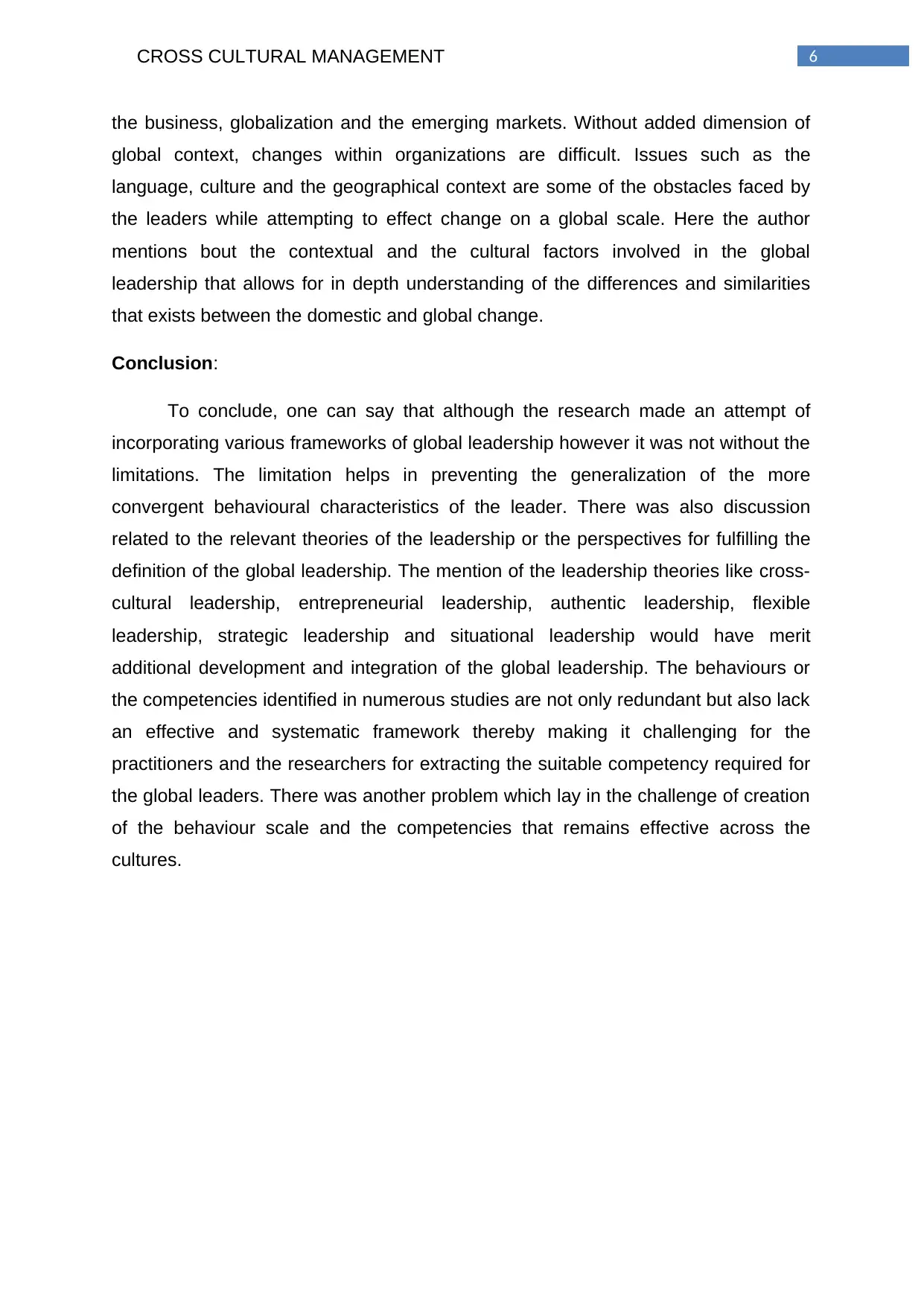
6CROSS CULTURAL MANAGEMENT
the business, globalization and the emerging markets. Without added dimension of
global context, changes within organizations are difficult. Issues such as the
language, culture and the geographical context are some of the obstacles faced by
the leaders while attempting to effect change on a global scale. Here the author
mentions bout the contextual and the cultural factors involved in the global
leadership that allows for in depth understanding of the differences and similarities
that exists between the domestic and global change.
Conclusion:
To conclude, one can say that although the research made an attempt of
incorporating various frameworks of global leadership however it was not without the
limitations. The limitation helps in preventing the generalization of the more
convergent behavioural characteristics of the leader. There was also discussion
related to the relevant theories of the leadership or the perspectives for fulfilling the
definition of the global leadership. The mention of the leadership theories like cross-
cultural leadership, entrepreneurial leadership, authentic leadership, flexible
leadership, strategic leadership and situational leadership would have merit
additional development and integration of the global leadership. The behaviours or
the competencies identified in numerous studies are not only redundant but also lack
an effective and systematic framework thereby making it challenging for the
practitioners and the researchers for extracting the suitable competency required for
the global leaders. There was another problem which lay in the challenge of creation
of the behaviour scale and the competencies that remains effective across the
cultures.
the business, globalization and the emerging markets. Without added dimension of
global context, changes within organizations are difficult. Issues such as the
language, culture and the geographical context are some of the obstacles faced by
the leaders while attempting to effect change on a global scale. Here the author
mentions bout the contextual and the cultural factors involved in the global
leadership that allows for in depth understanding of the differences and similarities
that exists between the domestic and global change.
Conclusion:
To conclude, one can say that although the research made an attempt of
incorporating various frameworks of global leadership however it was not without the
limitations. The limitation helps in preventing the generalization of the more
convergent behavioural characteristics of the leader. There was also discussion
related to the relevant theories of the leadership or the perspectives for fulfilling the
definition of the global leadership. The mention of the leadership theories like cross-
cultural leadership, entrepreneurial leadership, authentic leadership, flexible
leadership, strategic leadership and situational leadership would have merit
additional development and integration of the global leadership. The behaviours or
the competencies identified in numerous studies are not only redundant but also lack
an effective and systematic framework thereby making it challenging for the
practitioners and the researchers for extracting the suitable competency required for
the global leaders. There was another problem which lay in the challenge of creation
of the behaviour scale and the competencies that remains effective across the
cultures.
Paraphrase This Document
Need a fresh take? Get an instant paraphrase of this document with our AI Paraphraser
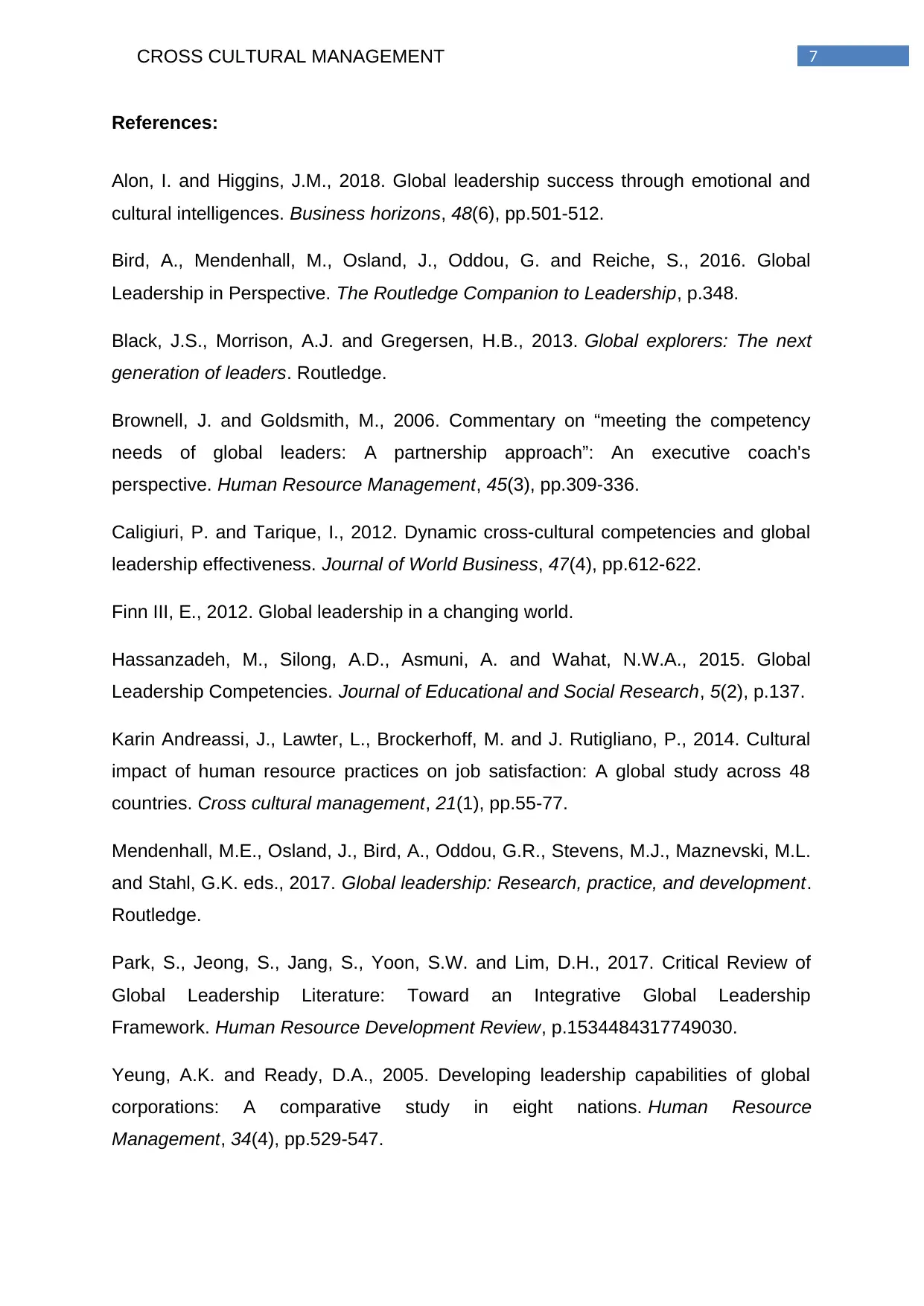
7CROSS CULTURAL MANAGEMENT
References:
Alon, I. and Higgins, J.M., 2018. Global leadership success through emotional and
cultural intelligences. Business horizons, 48(6), pp.501-512.
Bird, A., Mendenhall, M., Osland, J., Oddou, G. and Reiche, S., 2016. Global
Leadership in Perspective. The Routledge Companion to Leadership, p.348.
Black, J.S., Morrison, A.J. and Gregersen, H.B., 2013. Global explorers: The next
generation of leaders. Routledge.
Brownell, J. and Goldsmith, M., 2006. Commentary on “meeting the competency
needs of global leaders: A partnership approach”: An executive coach's
perspective. Human Resource Management, 45(3), pp.309-336.
Caligiuri, P. and Tarique, I., 2012. Dynamic cross-cultural competencies and global
leadership effectiveness. Journal of World Business, 47(4), pp.612-622.
Finn III, E., 2012. Global leadership in a changing world.
Hassanzadeh, M., Silong, A.D., Asmuni, A. and Wahat, N.W.A., 2015. Global
Leadership Competencies. Journal of Educational and Social Research, 5(2), p.137.
Karin Andreassi, J., Lawter, L., Brockerhoff, M. and J. Rutigliano, P., 2014. Cultural
impact of human resource practices on job satisfaction: A global study across 48
countries. Cross cultural management, 21(1), pp.55-77.
Mendenhall, M.E., Osland, J., Bird, A., Oddou, G.R., Stevens, M.J., Maznevski, M.L.
and Stahl, G.K. eds., 2017. Global leadership: Research, practice, and development.
Routledge.
Park, S., Jeong, S., Jang, S., Yoon, S.W. and Lim, D.H., 2017. Critical Review of
Global Leadership Literature: Toward an Integrative Global Leadership
Framework. Human Resource Development Review, p.1534484317749030.
Yeung, A.K. and Ready, D.A., 2005. Developing leadership capabilities of global
corporations: A comparative study in eight nations. Human Resource
Management, 34(4), pp.529-547.
References:
Alon, I. and Higgins, J.M., 2018. Global leadership success through emotional and
cultural intelligences. Business horizons, 48(6), pp.501-512.
Bird, A., Mendenhall, M., Osland, J., Oddou, G. and Reiche, S., 2016. Global
Leadership in Perspective. The Routledge Companion to Leadership, p.348.
Black, J.S., Morrison, A.J. and Gregersen, H.B., 2013. Global explorers: The next
generation of leaders. Routledge.
Brownell, J. and Goldsmith, M., 2006. Commentary on “meeting the competency
needs of global leaders: A partnership approach”: An executive coach's
perspective. Human Resource Management, 45(3), pp.309-336.
Caligiuri, P. and Tarique, I., 2012. Dynamic cross-cultural competencies and global
leadership effectiveness. Journal of World Business, 47(4), pp.612-622.
Finn III, E., 2012. Global leadership in a changing world.
Hassanzadeh, M., Silong, A.D., Asmuni, A. and Wahat, N.W.A., 2015. Global
Leadership Competencies. Journal of Educational and Social Research, 5(2), p.137.
Karin Andreassi, J., Lawter, L., Brockerhoff, M. and J. Rutigliano, P., 2014. Cultural
impact of human resource practices on job satisfaction: A global study across 48
countries. Cross cultural management, 21(1), pp.55-77.
Mendenhall, M.E., Osland, J., Bird, A., Oddou, G.R., Stevens, M.J., Maznevski, M.L.
and Stahl, G.K. eds., 2017. Global leadership: Research, practice, and development.
Routledge.
Park, S., Jeong, S., Jang, S., Yoon, S.W. and Lim, D.H., 2017. Critical Review of
Global Leadership Literature: Toward an Integrative Global Leadership
Framework. Human Resource Development Review, p.1534484317749030.
Yeung, A.K. and Ready, D.A., 2005. Developing leadership capabilities of global
corporations: A comparative study in eight nations. Human Resource
Management, 34(4), pp.529-547.
1 out of 8
Related Documents
Your All-in-One AI-Powered Toolkit for Academic Success.
+13062052269
info@desklib.com
Available 24*7 on WhatsApp / Email
![[object Object]](/_next/static/media/star-bottom.7253800d.svg)
Unlock your academic potential
Copyright © 2020–2025 A2Z Services. All Rights Reserved. Developed and managed by ZUCOL.





